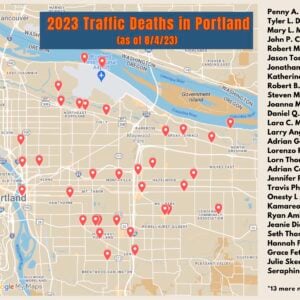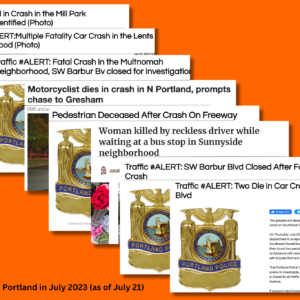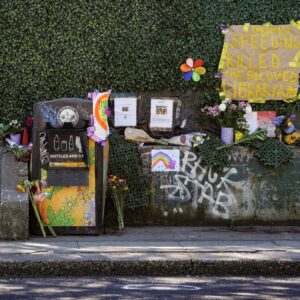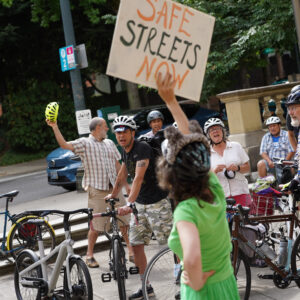With frustration building following the deadliest traffic month we’ve experienced in over 30 years, the Portland Bureau of Transportation and City Commissioner Mingus Mapps have announced a press conference to talk about it.
The event (intended for news media, but open to the public) will happen Monday morning (8/7), 11:00 am at City Hall. Here’s the announcement just put out by PBOT:
Transportation Commissioner Mingus Mapps and the Portland Bureau of Transportation (PBOT) invite the news media to attend at press conference on the disturbing recent rise in traffic deaths that have taken 43 lives so far this year in Portland, including 13 in the month of July. Multnomah County Chair Jessica Vega Pederson will join Commissioner Mapps at the event, at City Hall, for the release of a new report on traffic deaths as a public health issue. The Portland Police Traffic Division, Multnomah County Public Health and The Street Trust will also be represented at the press conference at the Fourth Avenue Plaza, Portland City Hall.
As I shared earlier today, this isn’t the first time we’ve gathered at City Hall for a press conference in the wake of a spate of traffic deaths. Former mayors and PBOT commissioners made similar announcements in 2007 and again in 2015.
Pressure on Commissioner Mapps has grown in recent weeks after highprofile traffic fatalities piled up. At a meeting of the PBOT Budget Advisory Committee last month, frustration boiled over as one of Mapps top policy advisors and PBOT staff were repeatedly harangued by committee members.
16 of the last 20 traffic deaths in Portland can be directly attributed to people speeding and/or driving under the influence of intoxicants. And the majority of serious crashes and fatalities happen in parts of Portland with a disproportionate number of residents who earn below average incomes and/or are Black, Indigenous or people of color. Because of those factors, the Multnomah County Health Department has become a larger player in local traffic safety conversations in recent years. Their Racial and Ethnic Approaches to Community Health (REACH) program published its first Transportation Crash and Safety Report in 2021.
PBOT said the press conference will focus on the County’s latest report. No other tangible actions were mentioned in the statement.
Stay tuned for a recap of Monday’s event.







Thanks for reading.
BikePortland has served this community with independent community journalism since 2005. We rely on subscriptions from readers like you to survive. Your financial support is vital in keeping this valuable resource alive and well.
Please subscribe today to strengthen and expand our work.
While 11 am on a Monday does not make it easy for many folks to attend, may I suggest ANY OF US WHO CAN ATTEND, SHOULD ATTEND. WEAR OUR HELMETS INTO THE PRESS CONFERENCE SO THEY KNOW THE BIKING COMMUNITY IS CONCERNED. I have witnessed numerous near-accidents at the same intersection where Jeanie Diaz was killed since her death (and far more before — it has been tragically obvious for years that reckless driving is worsening across the city), and I am happy to shout that to a room full of media. After waiting nicely to hear what detailed plan for addressing the problem Mingus Mapps will deliver, of course.
Christ on a cracker. It’s not that hard to take steps:
– no more parking right up to the corner (so, paint the curbs yellow and follow standard code)
– traffic enforcement via radar
– get serious about unregistered cars
I’m personally excited. As an insider to PBOT, I got a leak of the announcement. PBOT will be expanding on its innovative ‘Slow the flock down’ campaign by paying several hundreds of thousands of dollars to Deloitte to develop the “Slow the flock down – please? We really need you to stop killing people. We might have to actually improve things if this keeps up” campaign. Some of the top minds in gaslighting have contributed to this new campaign designed to do absolutely nothing to keep Portlanders safe while they move about the city. This innovative campaign will do absolutely nothing by continuing to ask motorist to improve their behavior, which we all know they want do.
Communications Director Hannah Schafer said “This new program will lead the nation in gaslighting taxpayers. We expect this effort to allow us to kick the can down the road for at least two years while allowing motorist to drive as fast as possible to the drunkest extent. We’d like to thanks Mingus Mapps for his contribution to allowing us to do absolutely nothing to address the problem, and we look forward to this absolutely useless relationship for years to come. God help any one not in car, you should buy a car, you poor lazy bum”
*Satire for those who can’t satire.
Schafer added, “Expect to see some major infrastructure improvements in the coming years as well. Together with our construction partners, we’ll be laying down over 30 square feet of green paint and several LED billboards urging drivers not to kill anyone.”
You joke, but I attended today’s news conference and Mapps did, in fact, actually say something very like this. (“Drivers should slow down” was the gist of his declaration.)
Yeah, that’s not going to do much. It only works when you use a stupid pun.
Yup. This is not satire; it’s pretty much what happened.
the very first and only question we should ask is how is the city going to BUDGET for the required changes.
I’m afraid this press conference will be just more pablum. It seems all we hear from leaders in the last 5 years is virtue signaling about how POC are disproportionately affected by x, y and z. Then we see EVERYONE (of ALL races, colors and creeds) continue to be killed and injured on our streets. I want pragmatic steps, not more repetition of ineffective ideology.
Exactly. But that kind of talk sells in Portland. You don’t have to provide actual results as we’ve so painfully seen.
More money diverted to nonprofits, less money for traffic enforcement. Elections have consequences.
I nominate this for “Comment of the week”!
About time.
Engineering
Education
Enforcement
It feels like the city has lost sight on all three of those fronts. Planners and politicians have little to no will to take space from cars and re-allocate it to people. We’ve got all the right street design tools to mitigate traffic deaths, but the city seems more interested in keeping drivers happy and keeping the status quo than anything else.
As many pointed out when the disappointing bike count numbers came out, lots of people have moved here from very car-dependent places with a culture of speeding and aggressive driving. I think that most people are well-meaning and want to do the right thing. Instead of “Slow The Flock Down”, PBOT should invest in simple, but informative billboards. For example, “Speed kills”, followed by “10% chance of death at 20mph, 25% chance of death at 30mph.” The general public doesn’t really understand why “20 is plenty” but most everyone in my life who I’ve confronted with that information has changed their driving habits.
It might not be a popular opinion around here – but there does need to be some education on how to bike and walk in a safe and predictable manner. I see way too many people darting across the street mid-block without looking (mostly drivers going to and from their cars lol), people riding the wrong way in bike lanes, or people weaving in and out of parked cars. Yes, we want the infrastructure and driving culture to improve, but even with the right political will it would take a generation to build a city where you could cross the street completely carefree 100% of the time.
The best short-term fix, though, is to hold drivers accountable for their behavior. We need speed and red light cameras all over the city. We have a culture of “yellow light means gun it” that absolutely needs to change. Drivers should be heavily fined – scaled for their income – for choosing to make dangerous maneuvers.
Automated enforcement is great but the cops also need to do their jobs. They need to get intoxicated drivers off our streets. I hate that “I might get a DUI” is a more powerful deterrent for drunk driving than “I might kill someone,” but that’s the reality we live in I suppose. Distracted drivers playing on their phones, dashboard ipads, etc need to experience the legal consequences of their choice. We have pretty strict laws regarding phone use while driving in Oregon, but the police need to actually pull people in order for those laws to mean anything.
We stopped doing any kind of traffic enforcement in the name of equity, but the great irony is that more Black and Brown folks are dying on our streets now than in decades.
Except Enforcement needs to be #1. We need a rapid return to normalcy. Infrastructure changes are years to decades away and education campaigns are no way as effective as consequences with a financial sting.
What is “normalcy?” Which year (US) Oregon/Portland (pg. 10) would be great to return to? The US has essentially relied solely on manned traffic enforcement for the entirety of its history. Which year was effective?
Infrastructure changes can happen overnight. We just need stuff like planters, old tires and a person in power to allow people to do it. The odd thing is: we don’t even need PBOT/city council to help.
It is the heavy reliance on manned enforcement that has put us in this position. Nearly every city that has made a concerted effort in investing in separating modes and building a separated network has had an increase in mode share. Alongside these investments in infrastructure automated speed cameras have been essential in reducing crashes in all developed countries including the US. The interim infrastructure is actually pretty cheap. It’s the cameras that cost a lot.
We need the exact opposite of a “return to normalcy.”
We’ve tried reliance on manual enforcement with some engineering, and as you pointed out, the results were not great. Now we’re trying minimal enforcement with a little more engineering, and I think we all agree it’s worse.
I think to make up lost ground, we’ll need to rely on both enforcement (automated and manual) and engineering. I am more skeptical about the power of education to help.
I am far more skeptical that citizens placing objects in the roadway without PBOT involvement will make things safer, but I’m happy to look at any research you have that supports this view.
I love when people ask for research! Awesome Watts! Portland used to have Better Block PDX (Better Block PSU), something I’ve found both personally rewarding and reasonably effective. I believe we took data. Demos have resulted in the 2th ave, Naito, SW Bway and some others, and someday hopefully a NE Broadway redesign. I’m suggesting something similar (and I would very much like to include 122nd on that list).
I doubt there is much research on “vigilante” road maintenance/design, although I too would like to read research on that. When I say the city just needs to get out of the way, I mean simply allow larger demonstrations/pilots with minimal guidance/funding.
For the last decade or more with respect to street safety PBOT/city council has acted as an agent for the status quo. Mapps perfectly embodied that apathy with his speech yesterday. Involving people in the process to change their neighborhood is essential to making a great city. Bogota has done a lot of that. My guess is Mapps, like Hardesty, like Eudaly don’t really know why cities do interim designs, and and don’t know how to get demonstrations to be an essential part of PBOT. My best guess is because PBOT is afraid of being sued and thinks primarily in terms of in capital projects/budget. That’s a perfect shit storm of status quo.
Yes, a Better Block is a good example of demonstration projects done right (and which have occasionally proven very effective).
Are you proposing that any self-appointed group be able to conduct their own similar demonstration projects? Should there be standards about what can and cannot be done or who can do it?
The process PBOT uses to plan, design and implement streets is inherently flawed and precludes most best-design practices. There is a clear disconnect between the information PBOT has, shares with its commissioners and public. Implementation should not rely primarily on an all-or-nothing capital project with traffic counts and abstract public input.
The public needs to see projects in action and give constructive input to an existing place in order to understand what they are talking about. These interim designs need to be baked in to most projects.
PBOT partners with better block, depave (they’re great BTW), for example, and other groups to implement projects, but these often take years to plan and build. The threshold for demos is extremely and unnecessarily high. And that threshold maintains the fictional narrative that streets cannot be changed without vast sums of money. In other parts of the world, where money is even scarcer, projects still get off the ground, and slowly, but inexorably grow.
PBOT can easily allow (even promote) better block, depave and other groups to fund, implement, take data on, and maintain interim projects with minimal oversight/assistance and huge benefits. They just wont. PBOT admin doesn’t see the benefit in this (they’re scared of being sued or making drivers mad). And so that possibility is clearly not passed on to the commissioners.
To answer your question, my hope is that PBOT can be persuaded to allow existing groups (see above) to build short-term demonstrations given basic guidelines “standards” (provided by PBOT). Because eventually people are going to see through PBOT’s facade. It’s pretty thin right now.
So essentially you want PBOT to develop a list of vetted organizations that are authorized to conduct their own design experiments without project-by-project input or oversight from PBOT, and create standards for data collection, oversight, and responsibility that these orgs would adhere to. Presumably these orgs would have to insurance and access to acceptable materials, and follow some established guidelines and standards, as well as any applicable laws. All this would of course need to be written down and approved by the city attorney.
That sounds very different from what I thought you were describing.
And is it so irrational to be scared of getting sued if you let people conduct experiments changing the way traffic works in ways that likely violate standard engineering standards and practice?
See above for input and oversight ^^. The current system sort of works already, but needs to be baked into project timelines. We tried x, and it did/didn’t work because y. That information is essential to getting capital projects right. Without that we get something like the Cully PBL. Or just pick a random PBOT project. There are so many truly unsafe/impractical designs. Nice on paper, but plain awful in reality.
NE Broadway is a perfect example of planning started in 1996, pilot in 2016 (20 years later), then full stop in order to wait for funding. Instead, PBOT needs to build momentum and maintain interim designs with cheap materials. We don’t need to pour concrete to dramatically change the efficiency and safety of streets. NYC DOT often does this with boulders and street paint to quickly separate or pedestrianize a part of a street, for example. I don’t think Portland lacks for boulders (or planters).
Yes, it’s absolutely irrational to be scared of promoting interim designs as an inherent part of street design. This should be PBOT’s main job. PBOT admin simply doesn’t care. This exists across the country in various forms and Portland has a long history of pilots already. It simply needs to be promoted/supported. If NYC can do it, PBOT can. There is an enormous difference between just “Keep Portland Moving” [no matter the consequences] and “Keep Portland [Safely and Efficiently] Moving.”
The liability associated with promoting interim designs is vastly different than that associated with allowing third parties to independently implement their own unvetted designs. We live in a sue-happy society, so legal exposure is something every agency needs to consider.
I have posted several times that I think PBOT should be doing more short-term experimental trials as part of their process, so I agree with you on that point.
The city that works:
1. A press-conference.
2. A committee of relevant “stakeholders” is formed (nonprofit industrial complex staff paid by city grants and neighborhood association members [funded by the city]).
3. A policy report/plan is crafted with “guidance” of city staff and presented to the public in a limited number of meetings with little opportunity to offer actionable input (often during working hours).
4. City council rubber stamps a completely unfunded policy report/plan.
5. City staff goes on expensive junkets to conferences in other cities to present glossy slides bragging about their new and unique policy.
6. City staff makes little progress on any of the specific policy items and complains about lack of funding (and lack of support by advocates).
7. Go to 1.
I believe that as of Jan 1, 2023, speed camera citations no longer need to be reviewed by a police officer.
Will PBOT be taking over the speed van? I’m a big fan of mobile speed cameras because they can cover different areas of the city so that folks don’t speed everywhere other than the known camera locations.
I’m always amazed how many people get citations from the van – even though they are required to put up a sign in advance warming drivers that the speed limit is being enforced.
This is low hanging fruit. And the citation revenue can run the program at PBOT.
The operators of the speed vans often hide the signs behind obstructions so that they get even more people.
I’ve learned to watch for the vans, not the signs.
why not just go the speed limit
Old truck, no cruise control, and too many different speed limits with signs not always viewable through trees and bushes.
Or more simply, because I’m not a perfect driver that can drive exactly the speed limit like you must be able to.
In other words, you’d have to work at it.
No cruise control? What about that giant thing on you dash that lists the current speed?
yeah those people blowing down my neighborhood street going 50 in a 20 must just be having trouble seeing the speed limit signs
Do you understand the meaning of the term “LIMIT“?
It does not mean exactly equal to it means that you should always drive below the speed LIMIT. 5 mph below the LIMIT is a good starting point and gives you plenty of room to not illegally exceed the LIMIT.
70% of Porltand streets are 20mph.
If you don’t know what 20mph *feels* like in your vehicle I suggest you go out on an empty road and practice driving it until you can do it without looking down.
Same for 30 and 40.
Pro Tip – you’ll never get a ticket for going 5mph over the speed limit.
And, yes, my dad would occasionally cover the speedo while he was teaching me to drive and say “how fast are you going”.
“I don’t know” was *not* an acceptable answer.
The simple fact of the matter is a large percentage of people aren’t competent to operate large machinery.
Seriously, this. “The” speed van – are you saying there’s only one? There should be at least a few if not dozens. Like you said, they’ll pay for themselves quickly (and I wouldn’t care if they didn’t).
E N F O R C E M E N T!
Even if cops just stopped motorists and gave them an oral warning, there would be some improvement.
*** Moderator: deleted last sentence, off-color ***
JM calls for action – and he gets it! Well, the usual performative Portland BS that will have no practical impact whatsoever.
I feel like Portland had all the the tools that they needed, and were on track to become a world class cycle & transit city, but they have not stayed on that track. For awhile, it seemed liked get back on track, and maybe also improve other things. Portland has not done that. Instead, they’ve spent the last 10 or 15 years undoing a lot of the progress the’ve made by bowing to the demands of real estate, developers and drivers.
I lost hope the day I saw *new* curb ramps pointing diagonally into Broadway (aka Banfield #2). I used to push a stroller when kids were young and those are suicide. Literally point you into traffic. Usually new ones have 2 ramps, but they don’t want anyone to actually cross Broadway without walking blocks to a signal.
Deliberately dangerous.
Spoiler, it’s cars